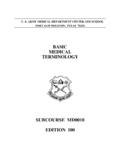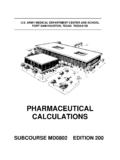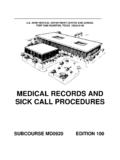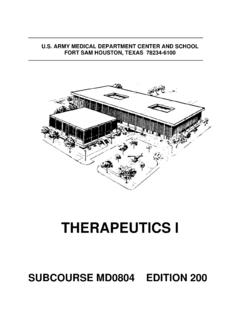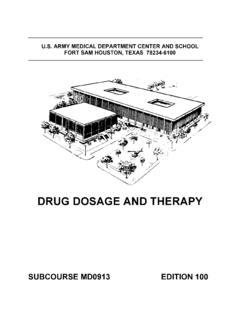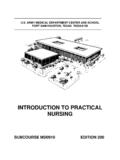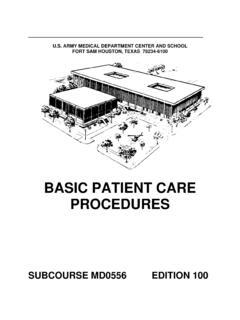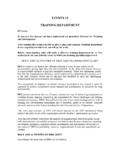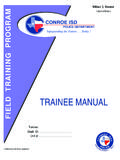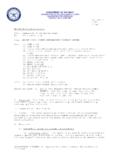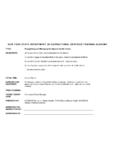Transcription of U.S. ARMY MEDICAL DEPARTMENT CENTER AND …
1 army MEDICAL DEPARTMENT CENTER AND school . FORT SAM HOUSTON, TEXAS 78234-6100. NURSING CARE RELATED TO THE MUSCULOSKELETAL SYSTEM. SUBCOURSE MD0916 EDITION 100. DEVELOPMENT. This subcourse is approved for resident and correspondence course instruction. It reflects the current thought of the Academy of Health Sciences and conforms to printed DEPARTMENT of the army doctrine as closely as currently possible. Development and progress render such doctrine continuously subject to change. ADMINISTRATION. For comments or questions regarding enrollment, student records, or shipments, contact the Nonresident Instruction Branch at DSN 471-5877, commercial (210) 221- 5877, toll-free 1-800-344-2380; fax: 210-221-4012 or DSN 471-4012, e-mail or write to: COMMANDER. AMEDDC&S. ATTN MCCS HSN. 2105 11TH STREET SUITE 4192. FORT SAM HOUSTON TX 78234-5064. Approved students whose enrollments remain in good standing may apply to the Nonresident Instruction Branch for subsequent courses by telephone, letter, or e-mail.
2 Be sure your social security number is on all correspondence sent to the Academy of Health Sciences. CLARIFICATION OF TRAINING LITERATURE TERMINOLOGY. When used in this publication, words such as "he," "him," "his," and "men" are intended to include both the masculine and feminine genders, unless specifically stated otherwise or when obvious in context.. TABLE OF CONTENTS. Lesson Page INTRODUCTION. 1 NURSING CARE RELATED TO THE MUSCULOSKELETAL SYSTEM. APPENDIX. UNIVERSAL BODY SUBSTANCE PRECAUTIONS. MD0916 i CORRESPONDENCE COURSE OF THE. UNITED STATES army MEDICAL DEPARTMENT CENTER AND school . SUBCOURSE MD0916. NURSING CARE RELATED TO THE MUSCULOSKELETAL SYSTEM. INTRODUCTION. The relationship between the patient and personnel providing nursing care can be an important factor in the patient's recovery. The nursing staff must have the knowledge and skills required to meet the physical and emotional needs of the patient.
3 The patient should be able to place his trust in the nursing staff, confident that well-trained, responsible individuals are assisting him and are interested in his well-being and return to good health and independence. The patient should not be thought of as the condition that brought him to the hospital. Health care providers should never refer to a patient as "the fractured hip" or "the ruptured disk." A comment of this type is very impersonal and may give a negative impression of the staff if overheard by the patient or by a family member. Because nursing paraprofessionals have close, bedside contact with the patient, they are often first to observe a complication in his condition. Their bedside presence should create a therapeutic environment. To foster this environment, the nursing paraprofessional should do the following: Assess the patient's ability to express himself. Assess the patient's ability to cope with his condition.
4 Assess the patient's level of understanding about his condition and the teaching provided by the health care professionals. Assist the patient in establishing a trusting relationship with the health care providers. Utilize the nursing process to provide the best possible care. Sustain and enhance his own professional knowledge and skills through continuing education and training. The purpose of this subcourse is to enhance your knowledge of MEDICAL -surgical nursing care related to the musculoskeletal system and the role of the nursing paraprofessional in providing that care. MD0916 ii Subcourse Components: This subcourse consists of one lesson and one appendix. Lesson 1. Nursing Care Related to the Musculoskeletal System. Appendix: Universal Body Substance Precautions. Study Suggestions: Here are some suggestions that may be helpful to you in completing this subcourse: --Read and study each lesson carefully.
5 --Complete the subcourse lesson by lesson. After completing each lesson, work the exercise at the end of the lesson, marking your answers in this booklet. --After completing each set of lesson exercises, compare your answers with those on the solution sheet that follows the exercise. If you have answered an exercise incorrectly, check the reference cited after the answer on the solution sheet to determine why your response was not the correct one. Credit Awarded: To receive credit hours, you must be officially enrolled and complete an examination furnished by the Nonresident Instruction Branch at Fort Sam Houston, Texas. Upon successful completion of the examination for this subcourse, you will be awarded 7 credit hours. You can enroll by going to the web site and enrolling under "Self Development" ( school Code 555). A listing of correspondence courses and subcourses available through the Nonresident Instruction Section is found in Chapter 4 of DA Pamphlet 350-59, army Correspondence Course Program Catalog.
6 The DA PAM is available at the following website: MD0916 iii LESSON ASSIGNMENT. LESSON 1 Nursing Care Related to the Musculoskeletal System. TEXT ASSIGNMENT Paragraphs 1-1 through 1-61. LESSON OBJECTIVES After completing this lesson, you should be able to: 1-1. Select the goal of orthopedic nursing. 1-2. Identify at least five observations that should be made during a nursing assessment of an orthopedic patient. 1-3. Identify at least five questions that should be asked when assessing a patient's orthopedic pain. 1-4. Select the procedures that should be used to instruct crutch-walking gaits. 1-5. Select four reasons for the use of casts. 1-6. Select the correct nursing management techniques used in caring for a patient with a cast. 1-7. Select the correct procedure for turning a patient in a spica cast. 1-8. Select five reasons for the use of traction. 1-9. Identify two basic methods of applying traction.
7 1-10. Match the correct definition to the terms contusion, sprain, strain, and dislocation. 1-11. Identify the signs and symptoms associated with fractures. 1-12. Given a description of a fracture injury, correctly classify that fracture. 1-13. Identify the three principles of fracture management. MD0916 1-1. 1-14. Given a description, select the principle of fracture management. 1-15. Select the nursing observations to be made when assessing a patient with a fracture. 1-16. Identify the signs and symptoms of four life-threatening complications of fractures. 1-17. Identify five reasons for amputating an extremity. 1-18. Given a list, select the nursing care implications involved in the care of a person who has undergone an amputation. 1-19. Given the location or description, identify the major bones of the body. 1-20. Select the procedure used to fit a patient for crutches. 1-21. Identify the tripod position.
8 1-22. Given a description, identify two types of traction. 1-23. Identify the nursing care management principles for a patient in traction. 1-24. Identify the difference between an open amputation and a closed amputation. 1-25. Select six factors that are considered by the physician when determining the location for amputation. 1-26. Identify the pathological changes seen in rheumatoid arthritis, osteoarthritis, and gout. 1-27. Identify the use, side effects and nursing care implications of drugs related to the musculoskeletal system. SUGGESTION After studying the assignment, complete the exercises at the end of this lesson. They will help you to achieve the lesson objectives. MD0916 1-2. LESSON 1. NURSING CARE RELATED TO THE. MUSCULOSKELETAL SYSTEM. Section I. INTRODUCTION TO ORTHOPEDIC NURSING. 1-1. THE MUSCULOSKELETAL SYSTEM. a. The musculoskeletal system is composed of bones, joints, muscles, cartilage, ligaments, and tendons.
9 The skeleton provides a structural framework for the body and, because bones are rigid, provides support and protection for vital organs and softer tissues. Skeletal muscles and bones work together to make body movement possible. Blood cell formation (called hematopoiesis) occurs in bone marrow, and bones store minerals such as calcium and phosphorus. b. Orthopedics is the branch of medicine and surgery that is concerned with the preservation and restoration of the function of the skeletal system, its articulations (joints), and its associated structures by MEDICAL , surgical, and physical means. c. Refer to figure 1-1 to refresh your knowledge of the names and locations of the major muscles and bones. 1-2. ORTHOPEDIC NURSING. a. The challenge in caring for the orthopedic patient is in carrying out basic nursing care procedures while understanding and working with orthopedic devices used in the treatment of musculoskeletal diseases and injuries.
10 To avoid self-injury, those engaged in orthopedic nursing must also understand and apply principles of good body mechanics. b. Many orthopedic patients are immobilized by casts, traction, or other means for long periods of time. Orthopedic nursing includes maintaining muscle tone and circulation to prevent contractures, deformity, and pressure sores by frequently changing the position of immobilized patients. c. Often confined to bed and in many cases immobile, the orthopedic patient may require a great deal of assistance with daily living activities. His bedding should be kept clean, dry, and wrinkle free. Because he is susceptible to skin breakdown and pressure sores, he should be assisted and encouraged to change positions within the limits prescribed by the physician. He should be encouraged to be as independent as possible within the limits of his immobility and personal hygiene should be emphasized.

